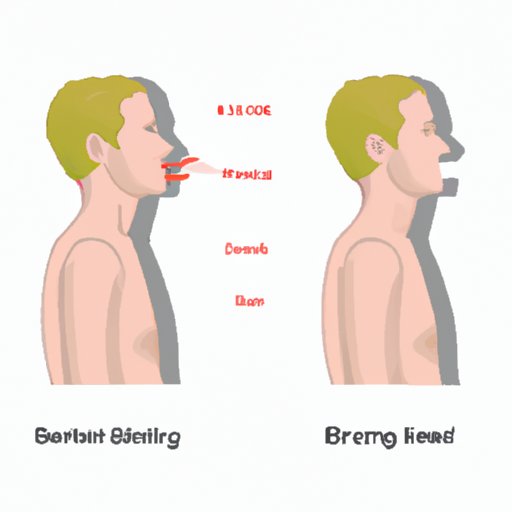Introduction
Feeling breathless is a common experience that many people encounter on a regular basis. It’s a sensation that can range from feeling slightly uncomfortable to being incredibly distressing. The experience can make it difficult to carry out everyday activities such as climbing stairs, exercising, or even having a conversation. In this article, we will explore the common causes of shortness of breath, how to manage it, and how to prevent it from occurring.
Understanding the Anatomy of Breathing
Before discussing the most common causes of shortness of breath, it’s important to understand how our body and respiratory system work to facilitate breathing. The respiratory system is made up of our lungs, diaphragm, and a network of muscles that work together to inhale and exhale air. When we inhale, our diaphragm, a muscle located underneath our lungs, contracts, and expands our lungs, pulling in air. When we exhale, the diaphragm relaxes, and our lungs compress, pushing air out.
There are many different factors that can interrupt this process and make breathing feel more difficult. For example, during exercise, our body requires more oxygen and we need to breathe faster and more deeply than usual. However, if our respiratory muscles are weak, this process can become difficult, leading to shortness of breath. Additionally, inflammation or blockages in the airways can also make it harder to breathe.
Why Shallow Breathing is a Common Issue
One common cause of shortness of breath is shallow breathing. Shallow breathing occurs when we use the upper part of our lungs rather than the entire lung capacity. When we breathe shallowly, less oxygen is taken into our body, leading to feelings of breathlessness or labored breathing.
Shallow breathing can occur due to a variety of reasons, such as poor posture, anxiety, or stress. Additionally, it’s not uncommon for people with respiratory diseases to breathe shallowly as a result of their condition.
The Physical and Psychological Causes of Breathlessness
In some cases, shortness of breath may be a symptom of an underlying health condition. Some medical conditions that can contribute to breathlessness include asthma, chronic obstructive pulmonary disease (COPD), anxiety, panic attacks, and even some types of lung cancer.
For individuals with asthma, the airways can become inflamed, making it more difficult to breathe. COPD, a lung condition often caused by smoking, causes damage to the lungs and airways, resulting in shortness of breath. Anxiety and panic attacks can also cause shortness of breath as a result of hyperventilation, which occurs when we breathe too quickly and take in too much oxygen. Lung cancer can cause shortness of breath by compressing the airway or causing fluid buildup in the lungs.
How to Manage Shortness of Breath
There are several strategies that can help manage shortness of breath. For individuals with medical conditions such as asthma or COPD, it’s essential to follow the treatment plan prescribed by a doctor. In some cases, this may include medication or breathing treatments to help widen the airways and make breathing easier.
Additionally, relaxation techniques such as deep breathing or meditation can help manage feelings of breathlessness caused by stress or anxiety. Breathing exercises, such as pursed-lip breathing or belly breathing, can also help slow down breathing and improve oxygen flow. Lifestyle changes, such as avoiding triggers that can induce shortness of breath or maintaining good respiratory health, can also be helpful for managing breathing difficulties.
Seek Medical Help
In some cases, shortness of breath may be an emergency situation that requires immediate medical attention. For example, anyone experiencing sudden and severe shortness of breath or trouble breathing accompanied by chest pain or other symptoms such as confusion or blue lips should seek emergency medical attention immediately by calling an ambulance or visiting the hospital.
It’s important to remember that medical care may be necessary to diagnose and treat underlying conditions that are causing shortness of breath. If experiencing persistent or worsening symptoms, it’s important to schedule an appointment with a healthcare professional.
Preventing Breathlessness
While not all causes of breathlessness can be prevented, following good respiratory care practices is critical in maintaining and improving lung function. Practicing good hygiene, such as washing your hands regularly and avoiding close contact with sick people, can help reduce the risk of respiratory infections. Additionally, avoiding smoking and other environmental irritants such as air pollution can help protect lung health and prevent breathing difficulties.
Conclusion
Shortness of breath is a common condition that can be caused by a wide range of factors. Whether it’s due to poor posture, respiratory diseases, anxiety, or stress, there are many strategies available for managing and preventing breathlessness. It’s important to work with healthcare professionals to diagnose and treat underlying health conditions, and to practice good respiratory care habits to maintain lung function.
Ultimately, taking care of our respiratory health is essential for maintaining a healthy and active lifestyle. With the right strategies and support, anyone can manage their symptoms and breathe easier.
